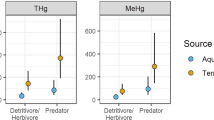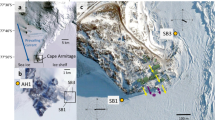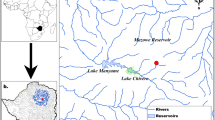Abstract
We tested the hypothesis that mercury (Hg) bioaccumulation in crayfish inhabiting acid mine-impacted streams increases with the severity of acidification. Sixty-four sites in southeast Ohio were ranked for severity of acid mine impact using an index of six water chemistry parameters (Fe, Mn, Al, sulfate, acidity, and pH) characteristic of acid mine drainage. Macroinvertebrate communities along the acid mine drainage (AMD) gradient were sampled by kick and dip net, and the abundances of different functional feeding groups characterized to evaluate differences in dietary prey availability to crayfish inhabiting AMD-impaired streams. Mercury in crayfish (Orconectes sanbornii) was measured at 19 sites. Composite samples (N = 10) of tail tissue from these sites were analyzed for mercury, along with sediment from six sites. Sediment methyl mercury (MeHg) ranged from 0.03 to 0.479 ng/g, typical of background (uncontaminated by Hg or AMD) levels for lakes and streams in this region. MeHg concentrations in crayfish tail tissue ranged from 26.7 to 122 ng/g. Contrary to our hypothesis, total Hg and MeHg in crayfish tissue were negatively correlated with acid mine impairment (r = −0.479, p = 0.036; r = −0.049, p = 0.0293, respectively), suggesting that crayfish bioaccumulate Hg more slowly in acid mine-impaired streams. This pattern is opposite of trends for increased bioaccumulation rates in food webs of lakes acidified by atmospheric deposition. Total macroinvertebrate (prey) abundance at study sites declined with increasing AMD impact. The reduced Hg accumulation in acid mine-impacted waters may be related to a change in diet, greater reliance on detritus-based food items, and/or lower trophic status of crayfish in acidified streams.




Similar content being viewed by others
References
Ahearn, G. A., Mandal, P. K., & Mandal, A. (2004). Mechanisms of heavy metal sequestration and detoxification in crustaceans: a review. Journal of Comparative Physiology. B, 174, 439–452.
Bott, T. L., Jackson, J. K., McTammany, M. E., Newbold, J. D., Rier, S. T., Sweeney, B. W., & Battle, J. M. (2012). Abandoned coal mine drainage and its remediation: impacts on stream ecosystem structure and function. Ecological Applications, 22, 2144–2163.
Bowling, A. M., Hammerschmidt, C. R., & Oris, J. T. (2011). Necrophagy by a benthic omnivore influences biomagnification of methylmercury in fish. Aquatic Toxicol, 102, 134–141.
Brigham, M. E., Wentz, D. A., Aiken, G. R., & Krabbenhoft, D. P. (2009). Mercury cycling in stream ecosystems. 1. Water column chemistry and transport. Environmental Science & Technology, 43, 2720–2725.
Chasar, L. C., Scudder, B. C., Stewart, A. R., Bell, A. H., & Aiken, G. R. (2009). Mercury cycling in stream ecosystems. 3. Trophic dynamics and methylmercury bioaccumulation. Environmental Science & Technology, 43, 2733–2739.
Chen, C. Y., Stemberger, R. S., Kamman, N. C., Mayes, B. M., & Folt, C. L. (2005). Patterns of Hg bioaccumulation and transfer in aquatic food webs across multi-lake studies in the Northeast US. Ecotoxicology, 14, 135–147.
Clayden, M. G., Kidd, K. A., Wyn, B., Kirk, J. L., Muir, D. C., & O’Driscoll, N. J. (2013). Mercury biomagnification through food webs is affected by physical and chemical characteristics of lakes. Environmental Science & Technology, 47(21), 12047–12053.
DeNicola, D. M., Layton, L., & Czapski, T. R. (2012). Epilithic community metabolism as an indicator of impact and recovery in streams affected by acid mine drainage. Environmental Management, 50, 1035–1046.
Drerup, S. A. (2016). Functional responses of stream communities to acid mine drainage remediation (Doctoral dissertation, Ohio University).
Driscoll, C. T., Mason, R. P., Chan, H. M., Jacob, D. J., & Pirrone, N. (2013). Mercury as a global pollutant: sources, pathways, and effects. Environmental Science & Technology, 47(10), 4967–4983.
Edmonds, S. T., O’Driscoll, N. J., Hillier, N. K., Atwood, J. L., & Evers, D. C. (2012). Factors regulating the bioavailability of methylmercury to breeding rusty blackbirds in northeastern wetlands. Environmental Pollution, 171, 148–154.
Fleming, E., Mack, E. E., Green, P. G., & Nelson, D. C. (2006). Mercury methylation from unexpected sources: molybdate inhibited sediments and an iron-reducing bacterium. Applied and Environmental Microbiology, 72, 457–464.
Gantner, N., Muir, D. C., Power, M., Iqaluk, D., Reist, J. D., Babaluk, J. A., Meili, M., Borg, H., Hammar, J., Michaud, W., & Dempson, B. (2010). Mercury concentrations in landlocked Arctic char (Salvelinus alpinus) from the Canadian Arctic. Part II: influence of lake biotic and abiotic characteristics on geographic trends in 27 populations. Environmental Toxicology and Chemistry, 29(3), 633–643.
George, B. M., & Batzer, D. (2008). Spatial and temporal variations of mercury levels in Okefenokee invertebrates: southeast Georgia. Environmental Pollution, 152(2), 484–490.
Gerhardt, A., Janssens de Bisthoven, L., & Soares, A. M. V. (2004). Macroinvertebrate response to acid mine drainage: community metrics and on-line behavioural toxicity bioassay. Environmental Pollution, 130, 263–274.
Gray, J. E., Hines, M. E., Higueras, P. L., Adatto, I., & Lasorsa, B. K. (2004). Mercury speciation and microbial transformations in mine wastes, stream sediments and surface waters at the Almaden Mining District, Spain. Environmental Science & Technology, 38, 4285–4292.
Hammerschmidt, C. R., & Fitzgerald, W. F. (2006). Methyl mercury in freshwater fish linked to atmospheric deposition. Environmental Science & Technology, 40, 7764–7770.
Hogsden, K. L., & Harding, J. S. (2012). Consequences of acid mine drainage for the structure and function of benthic stream communities: a review. Journal of the North American Benthological Society, 31, 108–120.
Jardine, T. D., Kidd, K. A., & O’Driscoll, N. (2013). Food web analysis reveals effects of pH on mercury bioaccumulation at multiple trophic levels in streams. Aquatic Toxicology, 132, 46–52.
Jeremiason, J. D., Engstrom, D. R., Swain, E. B., Nater, E. A., Johnson, B. M., Almendinger, J. E., Monson, B. A., & Kolka, R. K. (2006). Sulfate addition increases methyl mercury production in an experimental wetland. Environmental Science & Technology, 40, 3800–3806.
Johnson, K. S. (2007). Field and laboratory methods for using the MAIS (Macroinvertebrate Aggregated Index for Streams) in rapid bioassessment of Ohio streams. Accessed at www.epa.ohio.gov/dsw/credibledata/references.aspx .
Johnson, K. S. (2009). Performance of a family-level macroinvertebrate index (MAIS) for assessing acid mine impacts on streams in the Western Allegheny Plateau. Final report for Ohio Department of Natural Resources, Div. Mineral Resources. 45 pp.
Kamman, N. C., Chalmers, A., Clair, T. A., Moore, R. B., Norton, S. A., & Shanley, J. B. (2005). Factors influencing mercury in freshwater surface sediments of northeastern North America. Ecotoxicology, 14, 101–111.
Kerry, A., Welbourn, P. M., Prucha, B., & Mierle, G. (1991). Mercury methylation by sulfate-reducing bacteria from sediments of an acid-stressed lake. Water, Air, & Soil Pollution, 56, 565–575.
Kouba, A., Buřič, M., & Kozák, P. (2010). Bioaccumulation and effects of heavy metals in crayfish: a review. Water, Air, & Soil Pollution, 211(1–4), 5–16.
Lavoie, R. A., Jardine, T. D., Chumchal, M. M., Kidd, K. A., & Campbell, L. M. (2013). Biomagnification of mercury in aquatic food webs: a worldwide meta-analysis. Environmental Science & Technology, 47(23), 13385–13394.
Little, M. E., Burgess, N. M., Broders, H. G., & Campbell, L. M. (2015). Mercury in little brown bat (Myotis lucifugus) maternity colonies and its correlation with freshwater acidity in Nova Scotia, Canada. Environmental Science & Technology, 49(4), 2059–2065.
Marvin-DiPasquale, M., Lutz, M. A., Brigham, M. E., Krabbenhoft, D. P., Aiken, G. R., Orem, W. H., & Hall, B. D. (2009). Mercury cycling in stream ecosystems. 2. Benthic methylmercury production. Environmental Science & Technology, 43, 2726–2732.
Mason, R. P., & Lawrence, A. L. (1999). Concentration, distribution, and bioavailability of mercury and methylmercury in sediments of Baltimore Harbor and Chesapeake Bay, Maryland, USA. Environmental Toxicology and Chemistry, 18, 2438–2447.
Mason, R. P., Laporte, J. M., & Andres, S. (2000). Factors controlling the bioaccumulation of mercury, methylmercury, arsenic, selenium, and cadmium by freshwater invertebrates and fish. Archives of Environmental Contamination and Toxicology, 38, 283–297.
Méndez-Ortiz, B. A., Carrillo-Chávez, A., & Monroy-Fernández, M. G. (2007). Acid rock drainage and metal leaching from mine waste material (tailings) of a Pb-Zn-Ag skarn deposit: environmental assessment through static and kinetic laboratory tests. Revista Mexicana de Ciencias Geológicas, 24(2), 161–169.
Merritt, R. W., Cummins, K. W., & Berg, M. B. (2008). An introduction to the aquatic invertebrates of North America. Dubuque: Kendall Hunt.
Orem, W., Gilmour, C., Axelrad, D., Krabbenhoft, D., Scheidt, D., Kalla, P., McCormick, P., Gabriel, M., & Aiken, G. (2011). Sulfur in the South Florida ecosystem: distribution, sources, biogeochemistry, impacts, and management for restoration. Critical Reviews in Environmental Science and Technology, 41(S1), 249–288.
Parkman, H., & Meili, M. (1993). Mercury in macroinvertebrates from Swedish forest lakes: influence of lake type, habitat, life cycle and food quality. Canadian Journal of Fisheries and Aquatic Sciences, 50, 521–534.
Parks, J. W., & Hamilton, A. L. (1987). Accelerating recovery of the mercury-contaminated Wabigoon/English River system. Hydrobiology, 149, 159–188.
Parks, J. W., Craig, P. J., Neary, B. P., Ozburn, G., & Romani, D. (1991). Biomonitoring in the mercury–contaminated Wabigoon–English–Winnipeg river (Canada) system: selecting the best available bioindicator. Applied Organometallic Chemistry, 5(6), 487–495.
Pennuto, C. M., Lane, O. P., Evers, D. C., Taylor, R. J., & Loukmas, J. (2005). Mercury in the northern crayfish, Orconectes virilis (Hagen), in New England, USA. Ecotoxicology, 14, 149–162.
Peterson, S. A., Van Sickle, J., Herlihy, A. T., & Hughes, R. M. (2007). Mercury concentration in fish from streams and rivers throughout the western United States. Environmental Science & Technology, 41, 58–65.
Pinkney, A. E., Driscoll, C. T., Evers, D. C., Hooper, M. J., Horan, J., Jones, J. W., Lazarus, R. S., Marshall, H. G., Milliken, A., Rattner, B. A., Schmerfeld, J., & Sparling, D. W. (2014). Interactive effects of climate change with nutrients, mercury, and freshwater acidification on key taxa in the North Atlantic landscape conservation cooperative region. Integrated Environmental Assessment and Management, 11, 355–369.
Scheuhammer, A. M., Lord, S. I., Wayland, M., Burgess, N. M., Champoux, L., & Elliott, J. E. (2016). Major correlates of mercury in small fish and common loons (Gavia immer) across four large study areas in Canada. Environmental Pollution, 210, 361–370.
Schmitt, C. J., Stricker, C. A., & Brumbaugh, W. G. (2011). Mercury bioaccumulation and biomagnification in Ozark stream ecosystems. Ecotoxicology and Environmental Safety, 74(8), 2215–2224.
Shanley, J. B., Kamman, N. C., Clair, T. A., & Chalmers, A. (2005). Physical controls on total and methylmercury concentrations in streams and lakes of the northeastern USA. Ecotoxicology, 14, 125–134.
Shipp, W. G., & Zierenberg, R. A. (2008). Pathways of acid mine drainage to Clear Lake: implications for mercury cycling. Ecological Applications, 18, A29–A54.
Smith E.P. and Voshell J.R. (1997). Studies of benthic macroinvertebrates and fish in streams within EPA region 3 for development of biological indicators of ecological condition; part I, benthic macroinvertebrates. Report to USEPA, Cooperative Agreement CF821462010.
Smucker, N. J., & Vis, M. L. (2011). Acid mine drainage affects the development and function of epilithic biofilms in streams. Journal of the North American Benthological Society, 30, 728–738.
Sola, C., Burgos, M., Plazuelo, A., Toja, J., Plans, M., & Prat, N. (2004). Heavy metal bioaccumulation and macroinvertebrate community changes in a Mediterranean stream affected by acid mine drainage and an accidental spill (Guadiamar River, SW Spain). The Science of the Total Environment, 333, 109–026.
Stewart, R. A., Saiki, M. K., Kuwabara, J. S., Alpers, C. N., Marvin Di-Pasquale, M., & Krabbenhoft, D. P. (2008). Influence of plankton mercury dynamics and trophic pathways on mercury concentrations of top predator fish of a mining impacted reservoir. Canadian Journal of Fisheries and Aquatic Sciences, 65, 2315–2366.
Suarez-Serano, A., Alcaraz, C., Ibanez, C., Trobajo, R., & Barata, C. (2010). Procambarus clarkii as a bioindicator of heavy metal pollution sources in the lower Ebro River and Delta. Ecotoxicology and Environmental Safety, 73, 280–286.
Suchanek, T. H., Richardson, P. J., Zierenberg, R. A., Eagles-Smith, C. A., Slotton, D. G., Harner, E. J., Osleger, D. A., Anderson, D. W., Cech, J. J., Schladow, S. G., Colwell, A. E., Mount, J. F., King, P. S., Adam, D. P., & McElroy, K. J. (2008). The legacy of mercury cycling from mining sources in an aquatic ecosystem: from ore to organism. Ecological Applications, 18, A12–A28.
Swanson, H. K., & Kidd, K. A. (2010). Mercury concentrations in Arctic food fishes reflect the presence of anadromous Arctic charr (Salvelinus alpinus), species, and life history. Environmental Science & Technology, 44(9), 3286–3292.
Traister, E. M., McDowell, W. H., Krám, P., Fottová, D., & Kolaríková, K. (2013). Persistent effects of acidification on stream ecosystem structure and function. Freshwater Science, 32(2), 586–596.
Tsui, M. T. K., Finlay, J. C., & Nater, E. A. (2009). Mercury bioaccumulation in a stream network. Environmental Science & Technology, 43, 7016–7022.
USEPA. (1997). A citizens handbook to address contaminated acid mine drainage. US EPA Report #EPA-903-K-97-003, US EPA Region 3, Philadelphia, USA.
USEPA Western Ecology Division. (2007). Low-Level mercury contamination of fish tissue in Oregon streams. http://www.epa.gov/wed/pages/news/april01/peterson.htm.
Watras, C. J., Morrison, K. A., Regnall, O., & Kratz, T. K. (2006). The methyl mercury cycle in Little Rock Lake during experimental acidification and recovery. Limnology and Oceanography, 51, 257–270.
Williams D.R., Clark M.E., and Brown J.B. (1999). Stream water quality in coal mined areas of the Lower Cheat River basin, West Virginia and Pennsylvania, during low flow conditions, July 1997. United States Geological Survey Water Resources Investigations Report 98-4258.
Wong, A. H. K., McQueen, D. J., Williams, D. D., & Demers, E. (1997). Transfer of mercury from benthic invertebrates to fishes in lakes with contrasting fish community structure. Canadian Journal of Fisheries and Aquatic Sciences, 54, 1320–1330.
Wyn, B., Kidd, K. A., Burgess, N. M., & Curry, R. A. (2009). Mercury biomagnification in the food webs of acidic lakes in Kejimkujik National Park and National Historic Site, Nova Scotia. Canadian Journal of Fisheries and Aquatic Sciences, 66(9), 1532–1545.
Yatavelli, R. L. N., Fahrni, J. K., Kim, M., Crist, K. C., Vickers, C. D., Winter, S. E., & Connell, D. P. (2006). Mercury, PM2.5 and gaseous co-pollutants in the Ohio River Valley region: preliminary results from the Athens supersite. Atmospheric Environment, 40, 6650–6665.
Yu, X., Driscoll, C. T., Montesdeoca, M., Evers, D., Duron, M., Williams, K., Schoch, N., & Kamman, N. C. (2011). Spatial patterns of mercury in biota of Adirondack, New York lakes. Ecotoxicology, 20(7), 1543–1554.
Zizek, S., Horvat, M., Gibicar, D., Fajon, V., & Toman, M. J. (2007). Bioaccumulation of mercury in benthic communities of a river ecosystem affected by mercury mining. The Science of the Total Environment, 377, 407–415.
Acknowledgments
We thank Ohio University’s Consortium for Energy, Economics and the Environment (CE3) for funding the tissue mercury analyses and the Ohio Center for Ecology and Evolutionary Studies (OCEES) for providing EA with graduate research funding. Kyle Ebenhoch assisted with crayfish collection, and Lori Gromen assisted with crayfish collection and dissections. Special thanks to Jeff Thuma and the DiCaprio Lab, Biological Sciences Department, Ohio University for making their lyophilizer available. Kaabe Shaw and the Sunday Creek Watershed Group provided invaluable assistance in site selection, crayfish collection, and water chemistry sampling. The manuscript was improved by comments from three anonymous reviewers.
Author information
Authors and Affiliations
Corresponding author
Rights and permissions
About this article
Cite this article
Aluma, E., Johnson, K.S. & Hassett, P. Mercury Bioaccumulation in Crayfish in Acid Mine-Impaired Appalachian Streams. Water Air Soil Pollut 228, 200 (2017). https://doi.org/10.1007/s11270-017-3372-y
Received:
Accepted:
Published:
DOI: https://doi.org/10.1007/s11270-017-3372-y




